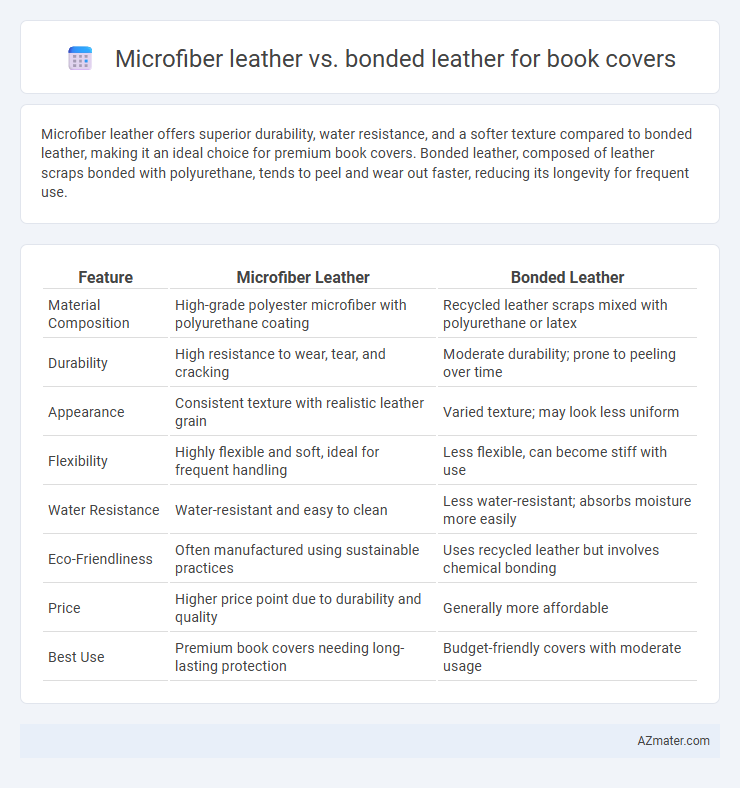Microfiber leather offers superior durability, water resistance, and a softer texture compared to bonded leather, making it an ideal choice for premium book covers. Bonded leather, composed of leather scraps bonded with polyurethane, tends to peel and wear out faster, reducing its longevity for frequent use.
Table of Comparison
| Feature | Microfiber Leather | Bonded Leather |
|---|---|---|
| Material Composition | High-grade polyester microfiber with polyurethane coating | Recycled leather scraps mixed with polyurethane or latex |
| Durability | High resistance to wear, tear, and cracking | Moderate durability; prone to peeling over time |
| Appearance | Consistent texture with realistic leather grain | Varied texture; may look less uniform |
| Flexibility | Highly flexible and soft, ideal for frequent handling | Less flexible, can become stiff with use |
| Water Resistance | Water-resistant and easy to clean | Less water-resistant; absorbs moisture more easily |
| Eco-Friendliness | Often manufactured using sustainable practices | Uses recycled leather but involves chemical bonding |
| Price | Higher price point due to durability and quality | Generally more affordable |
| Best Use | Premium book covers needing long-lasting protection | Budget-friendly covers with moderate usage |
Introduction to Book Cover Materials
Microfiber leather offers superior durability, water resistance, and a soft texture, making it an ideal material for long-lasting book covers. Bonded leather, composed of leather scraps and synthetic materials, is more affordable but tends to wear out faster and shows peeling over time. Choosing between microfiber and bonded leather depends on the desired balance of quality, cost, and aesthetic appeal for book cover materials.
What is Microfiber Leather?
Microfiber leather is a high-quality synthetic material made from ultra-fine polyester fibers combined with a polyurethane coating, offering durability and a soft, natural leather feel. It provides superior resistance to wear, water, and UV damage compared to bonded leather, making it ideal for protecting book covers. This environmentally friendly alternative mimics genuine leather's texture without the use of animal products or adhesives found in bonded leather.
What is Bonded Leather?
Bonded leather is a material made by combining shredded leather fibers with a polyurethane or latex backing, offering a cost-effective and eco-friendly alternative to genuine leather. Microfiber leather, unlike bonded leather, is a synthetic material engineered to mimic the texture and durability of real leather with superior resistance to wear and moisture. For book covers, bonded leather provides an affordable and biodegradable option, while microfiber leather ensures higher longevity and a more consistent appearance.
Durability: Microfiber vs Bonded Leather
Microfiber leather offers superior durability for book covers, resisting wear, scratches, and moisture better than bonded leather. Bonded leather, made from shredded leather fibers bonded with polyurethane, tends to peel and crack over time, especially with frequent handling. Choosing microfiber leather ensures a longer-lasting, more resilient cover that maintains its appearance under regular use.
Aesthetic Appeal and Texture Comparison
Microfiber leather offers a smooth, consistent texture that closely mimics genuine leather, providing a luxurious and refined aesthetic ideal for premium book covers. Bonded leather, composed of shredded leather fibers mixed with polyurethane, often presents an uneven surface and a less polished appearance, which may detract from the overall visual appeal. The durability and uniform finish of microfiber leather enhance tactile experience and long-lasting use, making it a preferred choice for high-quality bookbinding.
Environmental Impact and Sustainability
Microfiber leather, made from synthetic fibers like polyurethane and polyester, offers a more sustainable alternative to bonded leather by reducing the reliance on animal hides and minimizing waste. Bonded leather, composed of leftover leather scraps mixed with polyurethane, often involves significant chemical processing and generates more environmental pollutants. Choosing microfiber leather for book covers supports eco-friendly manufacturing practices with lower carbon emissions and enhanced durability, contributing to a reduced ecological footprint.
Cost Differences: Microfiber vs Bonded Leather
Microfiber leather generally costs more than bonded leather due to its higher durability and premium manufacturing process. Bonded leather, composed of leftover leather fibers bonded with polyurethane or latex, offers a budget-friendly alternative but lacks the longevity and quality of microfiber leather. Choosing between the two often hinges on balancing initial cost savings with long-term wear resistance for book covers.
Maintenance and Longevity
Microfiber leather offers superior durability and easier maintenance for book covers compared to bonded leather, resisting scratches, stains, and moisture more effectively. Bonded leather tends to wear out faster, with peeling and cracking common due to its composition of leather scraps and synthetic materials bound by adhesives. Regular cleaning with a damp cloth preserves microfiber leather's appearance, while bonded leather often requires special conditioners and is less resilient to long-term use.
Best Applications for Book Covers
Microfiber leather offers superior durability, water resistance, and a smooth texture, making it ideal for high-quality book covers that require long-lasting protection and a premium feel. Bonded leather, composed of leather scraps mixed with adhesives, suits budget-friendly covers but tends to wear out faster and is less resistant to moisture and abrasion. For book covers needing enhanced longevity and aesthetic appeal, microfiber leather is the preferred choice over bonded leather.
Conclusion: Choosing the Right Leather for Books
Microfiber leather offers superior durability, water resistance, and eco-friendliness, making it ideal for high-quality, long-lasting book covers. Bonded leather, while cost-effective and visually similar to genuine leather, tends to wear out faster and lacks the same level of strength. For book covers requiring longevity and premium feel, microfiber leather is the optimal choice.

Infographic: Microfiber leather vs Bonded leather for Book cover
 azmater.com
azmater.com